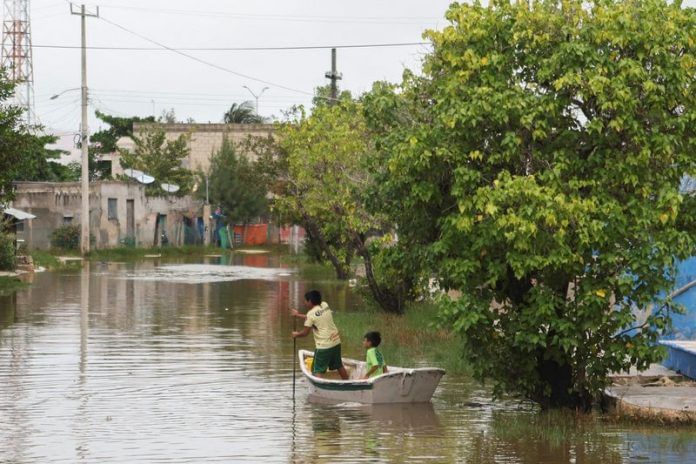By Gloria Dickie
(Reuters) – This year’s warm waters in the Gulf of Mexico helped Milton swiftly become a powerful hurricane, with the U.S. National Hurricane Center calling it the third-fastest intensifying Atlantic storm on record.
Milton’s rapid power surge appears to be the latest example of a worrying trend, scientists said, with climate change not only fuelling more powerful storms, but doing so more quickly.
Here is what you need to know:
WHAT IS BEHIND A STORM’S STRENGTH?
As storm winds organize into a hurricane, they pull energy from the heat in surface waters. The warmer the water, the more fuel for a hurricane.
Thanks to climate change, water temperatures are rising. In the last four decades, the ocean has absorbed about 90% of the warming from greenhouse gas emissions.
This year has seen especially warm waters due to climate change, with 2024 on track to have the warmest average global air temperature on record.
The past 12 months have seen global warming at 1.62 degrees Celsius (2.92 degrees Fahrenheit) above pre-industrial levels, the European Union’s Copernicus Climate Change Service said on Tuesday.
A storm’s strength is defined by its sustained wind speeds, with a Category 1 hurricane carrying wind speeds of 74-95 mph (119-153 kph), while a dangerous Category 5 storm has wind speeds of 157 mph (252 kph) or higher.
HOW IS STRENGTH DIFFERENT FROM INTENSIFICATION?
When a storm powers up quickly, scientists refer to its “rapid intensification.”
When a storm rapidly intensifies, sustained wind speeds increase by at least 35 mph (56 kph) within 24 hours, which can see a storm jump by two categories.
On Monday, Milton became the third-most rapidly intensifying Atlantic storm as its wind speeds increased by more than double the criteria for rapid intensification, shifting from a tropical storm to a Category 5 storm in less than a day.
The Gulf’s warm water, along with air conditions, made Milton’s rapid intensification “a near-certainty,” said physical oceanographer Gregory Foltz with the U.S. National Oceanic and Atmospheric Administration.
A study last year suggested that storms originating in the Atlantic Ocean are now more than twice as likely to strengthen from Category 1 to Category 3 in just 36 hours, based on data from 2001-2020 compared with 1971-1990.
That study, published in Scientific Reports, estimated that Atlantic storms overall are 29% more likely to undergo rapid intensification. While the study suggested this effect might be less pronounced for Gulf storms, the lead author told Reuters that unusually warm waters fuel storms wherever conditions are right.
Gulf of Mexico surface waters reached record-high temperatures around 90 degrees Fahrenheit (32 degrees Celsius) during the past two summers, according to NOAA data.
In mid-September, just weeks ahead of Milton’s formation, the Gulf was the warmest for that time of year on record.
“Watching Milton’s strengthening unfold in real time yesterday was still staggering,” said lead author Andra Garner of Rowan University in New Jersey.
Her calculations, shared with Reuters, suggest that Milton’s maximum 12-hour and 24-hour intensification rates on Monday ranked in the 99th percentile of all maximum intensification rates observed in the Atlantic.
WHY IS RAPID INTENSIFICATION A CONCERN?
Hurricanes can be deadly. They also cause some of the world’s costliest disasters, with the 10 costliest for the United States all occurring since 1989.
While Milton’s power-up was stunning, it occurred while the storm was still days from making landfall, giving Florida communities a chance to evacuate on Tuesday.
When a storm intensifies rapidly close to shore, it can leave communities scrambling to prepare or get out of harm’s way.
Mexico was surprised last year when a weak tropical storm in the Pacific suddenly became a powerful Category 5 storm called Hurricane Otis, just hours before it slammed into western Mexico and killed dozens of people in the Acapulco metropolitan area.
The most rapidly intensifying Atlantic hurricane on record is Wilma, a Category 5 storm when it hit the Yucatan Peninsula in October 2005, followed by Hurricane Felix in 2007.
One 2022 study in Geophysical Research Letters said that the intensification rate of near-shore Atlantic hurricanes had “increased significantly” during the 1979–2018 period. But like the 2023 study, it did not find a significant change in intensification speeds in Gulf storms.
(Reporting by Gloria Dickie; Writing by Katy Daigle; Editing by Rod Nickel)
Disclaimer: This report is auto generated from the Reuters news service. ThePrint holds no responsibilty for its content.






